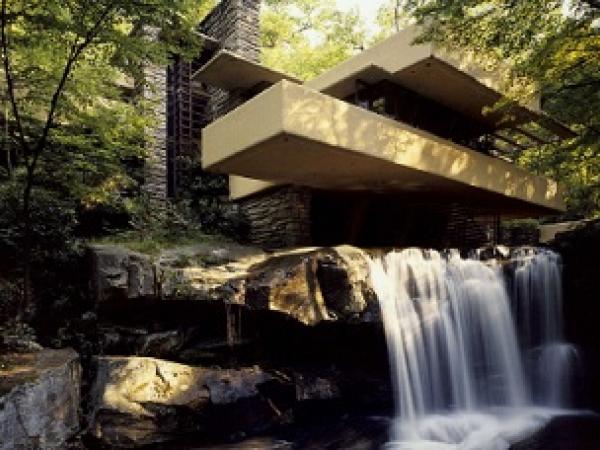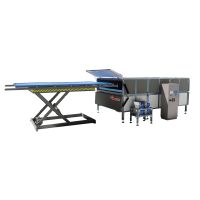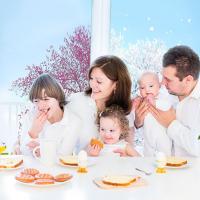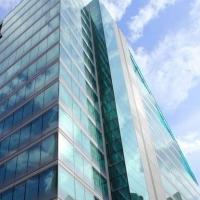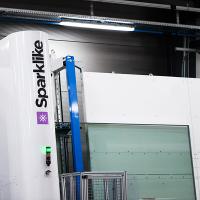Designed by Frank Lloyd Wright (1867-1959), arguably America's foremost architect, Fallingwater became a sensation almost overnight. Featured on the cover of 'Time' magazine in 1938 it has since become a National Historic Landmark in the USA. Its age defying aesthetics, both internally and externally, have recently been enhanced thanks to the use of SentryGlas® ionoplast interlayers deployed in recently installed replacement glazing.
.jpg)
The new glazing had to be as close as possible to the original plate glass; but also had to address the need to protect the interior wood and textiles from further UV damage.
Photos: Christopher Little, courtesy of the Western Pennsylvania Conservancy
.jpg)
The superior edge performance of SentryGlas®meant that the architect could use a butt-joint design where the panels met.
Photos: Christopher Little, courtesy of the Western Pennsylvania Conservancy
Built for the Kaufmann family, the house was constructed between 1936 and 1939. Its unique design and setting – over a 9.1m (30ft) waterfall – gives viewers the impression that it doesn’t appear to stand on solid ground; instead it stretches out over the waterfall giving the illusion of floating in air. Frank Lloyd Wright's reasoning for this approach was that he wanted the family to live with the waterfalls, to make them part of their everyday life, and not just to look at them now and then.
Since its original construction in the 30s, the building has been the subject of numerous renovation projects, including a major effort in the 1980s where the entire house was conserved for water and UV damage. However, the replacement glazing panels, which incorporated a PVB interlayer, are starting to show their age already, with clouding, water ingress and delamination. As a result of this the Western Pennsylvania Conservancy started to research alternative replacement panels and its investigations all pointed in one direction – laminated panels incorporating SentryGlas®.
According to Lynda S. Waggoner, Director of Fallingwater and Vice President of the Western Pennsylvania Conservancy and Scott W. Perkins, Director of Preservation: "We wanted to get as close as we could to the original 1/4in (6.4mm) plate glass, but we had concerns regarding colour and clarity; we definitely did not want any tinting or diffusion. This desire had to be countered with the need to protect the interior wood and textiles from further UV damage.
.jpg)
"We started our research in 2008 by undertaking comparisons between glass with films and glass with interlayers," Waggoner explains, "but we soon realised that films had a huge impact on the colour and clarity, giving us green and grey tints. In addition we saw a risk of bubbles and peeling at the edges. It was soon clear to us that the best approach would be to use an interlayer, which also meant that the maintenance and housekeeping staff could treat the new panels as they would monolithic glass panels – without the worry of damaging any sensitive films with scratches or chemicals."
When it came down to the choice of interlayers, the performance of PVB in the earlier re-glazing exercise meant that an alternative was being sought and SentryGlas® soon became the clear winner thanks to outperforming PVB in all tests.
"We undertook some sample comparisons," Perkins explains, "where we installed some test glazing on the west terrace, just to look at it, and this was the final determination. In situ you get a real appreciation of the effect of the glazing, or in this instance the lack of detrimental effects. We also realised that the superior edge performance of SentryGlas® meant that we could use a butt-joint design."
A lot of the glazing evaluation and trials were undertaken with the input and advice of Bob Randle, then President of Traco, which is now owned by Kawneer, part of Alcoa. Traco undertook the original lamination, while PPG Industries provided the glass. "It was Bob that suggested the use of SentryGlas® as the interlayer," Waggoner elaborates. "We wanted a better solution as we knew the technology had progressed. But we also had to consider the use of tempered glass, as the general public can visit the house and we had to balance these functional needs with the aesthetic requirements laid down by the Department of the Interior's standards with regards to like-for-like, sympathetic replacements."
Waggoner concludes: "At Fallingwater there is no single focus; visitors come to see the inside and the outside and the views of both from one another. Transparency and true colour transmission is vital. We had a number of interesting and unusual glazing applications based on Frank Lloyd Wright's original vision, so we needed glass that could perform!"
Lighter façade panels enable more subtle supporting structures
For decades, interlayers made of polyvinyl butyral (PVB) have been the industry standard when producing laminated safety glass. Architects are well aware of the possibilities and limitations of such glass when used extensively in façade engineering, for roofing and window panels. In contrast, SentryGlas® enables an entirely new approach because the interlayer is over 100 times stiffer and five times stronger than PVB. As a consequence, there is an almost perfect transmission of load between two laminated sheets of glass, even at high temperatures, leading to the excellent flexural behavior of the glass when under load – also under direct sunlight in high summer. Accordingly, laminates with SentryGlas® show less than half the rate of deflection when compared to laminates with PVB, when under the same load, and thus almost the same behavior as monolithic glass of the same thickness.
.jpg)
Main benefits of SentryGlas®:
- Safety
In the event of breakage, glass fragments remain firmly bonded to the interlayer, reducing the chance for injury. - Security
SentryGlas® can be used in glazing that withstands bullets, hurricane-force winds and even bomb blasts. - Solar energy control:
SentryGlas® can be used with coated low-E glass for improved energy efficiency. It can also help engineer more effective thermally insulated glass, and glass with better controlled (or allowed) transmittance of V radiation. - Durability
SentryGlas® is extremely durable and resistant to clouding, even after years of exposure. - Design Versatility
SentryGlas® can be used in glass manufactured flat or curved, including annealed, toughened, heat-strengthened, spandrel, wired, patterned and color tinted glass.

